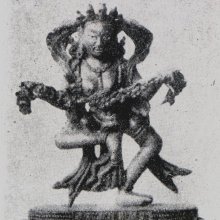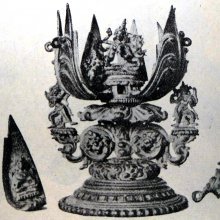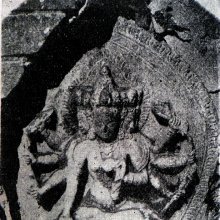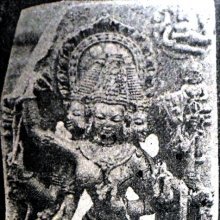Vindhya, Vimdhya: 29 definitions
Introduction:
Vindhya means something in Hinduism, Sanskrit, Jainism, Prakrit, the history of ancient India, Marathi. If you want to know the exact meaning, history, etymology or English translation of this term then check out the descriptions on this page. Add your comment or reference to a book if you want to contribute to this summary article.
Images (photo gallery)
In Hinduism
Purana and Itihasa (epic history)
Source: Wisdom Library: Varāha-purāṇaVindhya (विन्ध्य).—One of the seven holy mountains (kulaparvata) situated in Bhārata, a region south of mount Meru, according to the Varāhapurāṇa chapter 85. In the settlements (janapada) along these mountains dwell Āryas and Mlecchas who drink water from the rivers flowing there. Meru is one of the seven mountains located in Jambūdvīpa, which is ruled over by Āgnīdhra, a grandson of Svāyambhuva Manu, who was created by Brahmā, who was in turn created by Nārāyaṇa, the unknowable all-pervasive primordial being, who was created by Brahmā, who was in turn created by Nārāyaṇa, the unknowable all-pervasive primordial being.
Source: archive.org: Puranic EncyclopediaVindhya (विन्ध्य).—One of the seven chief mountain chains. This mountain which separates South India from North India is famous in various ways in the Purāṇas.
(i) Agastya kicked Vindhya down. (See under Agastya).
(ii) Sunda and Upasunda, two asuras, did penance on Vindhya and got boons. (Mahābhārata Ādi Parva, Chapter 208, Stanza 7).
(iii) Because of the fierce penance of Sunda, the mountain Vindhya became hot and from that day onwards smoke comes out from Vindhya. (Mahābhārata Ādi Parva, Chapter 208, Stanza 10).
(iv) The deity of Vindhya stays in the palace of Kubera serving him. (Mahābhārata Sabhā Parva, Chapter 10, Stanza 31).
(v) On this mountain there is the eternal abode of Devī Durgā. (Mahābhārata Virāṭa Parva, Chapter 6, Stanza 17).
(vi) Vindhya is one of the seven chief mountain chains. (Mahābhārata Bhīṣma Parva, Chapter 9, Stanza 11).
(vii) In Tripuradahana (the burning of Tripuras) Vindhya appeared behind the chariot of Śiva as the emblem on his flag. (Mahābhārata Droṇa Parva, Chapter 202, Stanza 71);
(viii) Vindhya once became the axle of the chariot of Śiva. (Mahābhārata Karṇa Parva, Chapter 34, Stanza 22).
(ix) This mountain gave Subrahmaṇya two attendants named Ucchṛṅga and Atiśṛṅga. (Mahābhārata Śalya Parva, Chapter 45, Stanza 49).
(x) Mention is made in Mahābhārata, Anuśāsana Parva, Chapter 25, Stanza 49, that he who does penance on the Vindhya, for a month without killing any living creature, could obtain all attainments.
Source: archive.org: Shiva Purana - English TranslationVindhya (विन्ध्य) is the name of a Mountain, according to the Śivapurāṇa 2.3.36 (“The statements of the seven sages”).—Accordingly, as Himavat (Himācala) said to the other mountains: “O lord of mountains—Meru, O Sahya O Gandhamādana, O Mandara, O Maināka, O Vindhya, all of you listen to my words. Vasiṣṭha says like this. It is to be considered what I shall do now. You consider well, decide and let me know”.
Source: Cologne Digital Sanskrit Dictionaries: The Purana Index1a) Vindhya (विन्ध्य).—A mountain (Kulaparvata, Vāyu-purāṇa) in Bhārata varṣa. Here Dakṣa performed tapas;1 a Kulaparvata sacred for Śrāddha offerings.2 Here Haihaya came for hunting: Kṛṣṇa went there in search of Prasena;3 sacred to Vindyādhivāsinī and the Pitṛs;4 caused by Agastya to bow down and not to rise in height;5 joining with the Ganges is more sacred than Kurukṣetra;6 rivers originating from;7 obstructed by it the Gaṅgā enters the sea;8 Goddess of night was asked to seek shelter in the Vindhyas after she left Umā's body.9
- 1) Bhāgavata-purāṇa V. 19. 16; VI. 4. 20; Viṣṇu-purāṇa II. 3. 3.
- 2) Brahmāṇḍa-purāṇa II, 16. 19; III. 7. 356; 13. 34; Matsya-purāṇa 114. 18; Vāyu-purāṇa 45. 89; 58. 81; 69. 239; 77. 34; 88. 199; 96. 38.
- 3) Brahmāṇḍa-purāṇa III. 26. 25; 71. 39.
- 4) Matsya-purāṇa 13. 39; 22. 66.
- 5) Ib. 61. 51.
- 6) Ib. 106. 49.
- 7) Ib. 114. 27-8; Vāyu-purāṇa 45. 103.
- 8) Matsya-purāṇa 121. 51; Vāyu-purāṇa 47. 50.
- 9) Matsya-purāṇa 157, 17, 19.
1b) A son of Raivata Manu.*
- * Bhāgavata-purāṇa VIII. 5. 2.
Vindhya (विन्ध्य) refers to the name of a Mountain mentioned in the Mahābhārata (cf. VI.10.10, IX.44.13, IX.44.45). Note: The Mahābhārata (mentioning Vindhya) is a Sanskrit epic poem consisting of 100,000 ślokas (metrical verses) and is over 2000 years old.

The Purana (पुराण, purāṇas) refers to Sanskrit literature preserving ancient India’s vast cultural history, including historical legends, religious ceremonies, various arts and sciences. The eighteen mahapuranas total over 400,000 shlokas (metrical couplets) and date to at least several centuries BCE.
Kavya (poetry)
Source: archive.org: Aspects of Bengal society: Ship-building and commerceVindhya is the name of an ancient city mentioned by the author of the Kavikankan’s Chandikāvya pp. 195-202.—Accordingly, after the performance of the usual ceremonies before sailing, the merchant Dhanapati passed the following places: [...]—all by the side of the Ganges. Then he reached the very celebrated inland port of Bengal known as Saptagram near the Tribeni. The poet here incidentally praised this port and gave it a superiour place among the following ports and places: [e.g., Vindhya, etc...]. According to the poet the merchants of the above places visit Saptagram but the merchants of Saptagram do never visit those ports and places.
Source: Shodhganga: A critical appreciation of soddhalas udayasundarikathaVindhya (विन्ध्य).—One of the eight kulaparvatas (boundary-mountains) mentioned by Soḍḍhala.—The Vindhya mountain is the famous mountain range of that name, which divides the Bharata-varṣa into two great parts, the north and the south. It is from here that the two high ways of the Uttarāpatha and Dakṣiṇāpatha started respectively to the North and the South. The Southern Ṛkṣa, Pāriyatra and Vindhya proper together make up what we call the Vindhya range.
Source: Shodhganga: The Kavyamimamsa of RajasekharaVindhya (विन्ध्य) is the name a locality mentioned in Rājaśekhara’s 10th-century Kāvyamīmāṃsā.—Vindhyadakṣināpatha or the Vindhya Range or the Satpura hills between the Tāpī and Narmadā.

Kavya (काव्य, kavya) refers to Sanskrit poetry, a popular ancient Indian tradition of literature. There have been many Sanskrit poets over the ages, hailing from ancient India and beyond. This topic includes mahakavya, or ‘epic poetry’ and natya, or ‘dramatic poetry’.
Ayurveda (science of life)
Source: archive.org: Vagbhata’s Ashtanga Hridaya Samhita (first 5 chapters)Vindhya (विन्ध्य) is the name of a region whose waters (i.e., rivers) produce negative conditions, as mentioned in verse 5.11-12 of the Aṣṭāṅgahṛdayasaṃhitā (Sūtrasthāna) by Vāgbhaṭa.—Accordingly, “[...] (those) [rivers, viz., nadī] again springing from the Sahya and Vindhya; [produce] leprosy, jaundice, and diseases of the head; (those) coming from the Pāriyātra (are) destructive of the (three) humours (and) promotive of strength and virility”.
Note: The Vindhya is the eastern division of the Vindhya mountains, as against the Pāripātra or Pāriyātra, their northern and western division (see next stanza). [...] Vindhya has been Tibetanizcd as binda; CD write bin-da, breaking the ligature.

Āyurveda (आयुर्वेद, ayurveda) is a branch of Indian science dealing with medicine, herbalism, taxology, anatomy, surgery, alchemy and related topics. Traditional practice of Āyurveda in ancient India dates back to at least the first millenium BC. Literature is commonly written in Sanskrit using various poetic metres.
Shaktism (Shakta philosophy)
Source: Google Books: Manthanabhairavatantram1) Vindhya (विन्ध्य) (mountain) is the name of a sacred region, according to the Śrīmatottara-tantra verse 3.135-138, an expansion of the Kubjikāmatatantra: the earliest popular and most authoritative Tantra of the Kubjikā cult.—The eight secondary fields are Kadaṃba, Alamba, Gokarṇa, the Vindhya mountain, Vimaleśvara, Sindhumāla, Mahāsena, and Mātaṅga.
2) Vindhya (विन्ध्य) is the name of a Prince associated with the Pīṭha named Dakṣiṇādi, according to the Kulakriḍāvatāra, a text paraphrased by Abhinavagupta in his Tāntrāloka.—The lineage (ovalli) Yogin is associated with the following:—Prince: Vindhya; Master: Śāṇḍilya-muni; Pīṭha: Dakṣiṇādi; Ghara (house): Śarabilla; Pallī (village): Akṣara; Town: Piṇḍa; Direction: south-west; Grove: Khaira; Vow-time: 25 years; Mudrā: right little finger; Chummā: “Navel”.

Shakta (शाक्त, śākta) or Shaktism (śāktism) represents a tradition of Hinduism where the Goddess (Devi) is revered and worshipped. Shakta literature includes a range of scriptures, including various Agamas and Tantras, although its roots may be traced back to the Vedas.
Shaivism (Shaiva philosophy)
Source: Google Books: Manthanabhairavatantram (shaivism)Vindhya (विन्ध्य) refers to one of the disciples of Meṣa or Meṣanātha: one of the “four Lords (teachers) of the Ages” (Yuganātha), according to the Kulakrīḍāvatāratantra.—Matsyendranātha is worshipped as the teacher of this Age along with three other teachers and their consorts who brought the Kaula Tantra into the world in the previous three Ages. These four Lords of the Ages (yuganātha) are highly revered in the Kālīkrama and came to be considered to be embodiments of the basic states of consciousness. Disciples of Meṣanātha: According to the Kulakrīḍāvatāra-tantra: Vindhya and Ajita or Kullāīambā and Ajaramekhalā; According to the Ciñcinīmatasārasamuccaya: Vicitra and Vidhīndunātha.

Shaiva (शैव, śaiva) or Shaivism (śaivism) represents a tradition of Hinduism worshiping Shiva as the supreme being. Closely related to Shaktism, Shaiva literature includes a range of scriptures, including Tantras, while the root of this tradition may be traced back to the ancient Vedas.
Jyotisha (astronomy and astrology)
Source: Wisdom Library: Brihat Samhita by VarahamihiraVindhya (विन्ध्य) is the name of an ancient country or sacred region, according to the Bṛhatsaṃhitā (chapter 16) (“On the planets—graha-bhaktiyoga”), an encyclopedic Sanskrit work written by Varāhamihira mainly focusing on the science of ancient Indian astronomy astronomy (Jyotiṣa).—Accordingly, “[...] Mars also presides over the country of Uttarapāṇḍya, the Mahendra, the Vindhya, the Malaya mountains, Colādeśa, the Draviḍas, the Videhas, the Āndhras, the Aśmakas, the Bhāsapuras, the Kauṅkaṇas, the Mantriṣikās, the Kuntalas, the Keralas, the Daṇḍakas, the Kāntipuras, the Mlecchas and the mixed races”.

Jyotisha (ज्योतिष, jyotiṣa or jyotish) refers to ‘astronomy’ or “Vedic astrology” and represents the fifth of the six Vedangas (additional sciences to be studied along with the Vedas). Jyotisha concerns itself with the study and prediction of the movements of celestial bodies, in order to calculate the auspicious time for rituals and ceremonies.
Vastushastra (architecture)
Source: Shodhganga: Elements of Art and Architecture in the Trtiyakhanda of the Visnudharmottarapurana (vastu)Vindhya (विन्ध्य) refers to one of the hundred types of Temples (in ancient Indian architecture), according to the Viṣṇudharmottarapurāṇa, an ancient Sanskrit text which (being encyclopedic in nature) deals with a variety of cultural topics such as arts, architecture, music, grammar and astronomy.—It is quite difficult to say about a definite number of varieties of Hindu temples but in the Viṣṇudharmottarapurāṇa hundred varieties of temples have been enumerated. For example, Vindhya. These temples are classified according to the particular shape, amount of storeys and other common elements, such as the number of pavilions, doors and roofs.

Vastushastra (वास्तुशास्त्र, vāstuśāstra) refers to the ancient Indian science (shastra) of architecture (vastu), dealing with topics such architecture, sculpture, town-building, fort building and various other constructions. Vastu also deals with the philosophy of the architectural relation with the cosmic universe.
In Jainism
Jain philosophy
Source: archive.org: Anekanta Jaya Pataka of Haribhadra SuriVindhya (विन्ध्य) refers to “one of the seven principal mountains”, as occurring in the Anekāntajayapatākā-prakaraṇa, a Śvetāmbara Jain philosophical work written by Haribhadra Sūri.—[Cf. Vol. I, P. 132, l. 30]—‘Vindhya’ is the name of one of the seven principal mountains. It forms the southern boundary of Āryāvarta The word ‘Vindhya’ occurs on p. 220, l. 23 and in Raghuvaṃśa (XII, 31).
-
General definition (in Jainism)
Source: archive.org: TrisastisalakapurusacaritraVindhya (विन्ध्य) is the name of a caravan-leader from Gajapura, according to the Jain Ramayana and chapter 7.7 [The killing of Rāvaṇa] of Hemacandra’s 11th century Triṣaṣṭiśalākāpuruṣacaritra: an ancient Sanskrit epic poem narrating the history and legends of sixty-three illustrious persons in Jainism.—Accordingly, Praticandra said to Bhāmaṇḍala: “[...] I, astonished by the immediate healing of the blow, asked Bharata about the power of the perfumed water and your younger brother related. ‘A caravan-leader, named Vindhya, came here from Gajapura. One of his buffaloes, worn out by an excessive burden, fell on the road. [...]’.”.

Jainism is an Indian religion of Dharma whose doctrine revolves around harmlessness (ahimsa) towards every living being. The two major branches (Digambara and Svetambara) of Jainism stimulate self-control (or, shramana, ‘self-reliance’) and spiritual development through a path of peace for the soul to progess to the ultimate goal.
India history and geography
Source: archive.org: Geography in Ancient Indian inscriptionsVindhya (विन्ध्य) is the name of one of the seven kulaparvata (clan mountain) of Bhāratavarṣa, associated with a distinct country or tribe.—As ascertained by Professor Hemachandra Raychaudhuri, Vindhya is the mountain par excellence of the Āṭavtyas and other forest folk of Central India. Apart from its mention in the Nasik eulogy, the Vindhya mountain is mentioned in eight other inicription. Mandsaur inscription of Yalodharman and Viṣṇuvardhana refers to a tract of land, containing many countries. which lie between the Vindhya from the slopes of the summit of which there fiows the pale mass of the waters of Revā, and the mountain Pāriyātra. on which the trees are bent down in (their) frolicsome leaps by the long-tailed monkeys (and stretches) upto the ocean (Sindhu).
The Vindhya mountain comprised the chains of the ranges at the source of the Narmadā and Tāptī, and though most conspicuous in Western and central India, it extends right across the Peninsula, until passing through the neighbourhood of Gaya, its easternmost spurs reach and disappear in the valley of the Gaṅgā at Rajmahalas. Moreover, it appears that Vijha of the Nasik-praśasti denotes ‘the eastern Vindhyas’.
Source: archive.org: Nilamata Purana: a cultural and literary study (history)Vindhya (विन्ध्य) refers to one of the seven kulaparvatas (chief mountains) mentioned in the Nīlamatapurāṇa. Vindhya refers to that portion of the Vindhya range where from rise the Narmadā and the Tāptī.
Source: archive.org: Shiva Purana (history)Vindhya (विन्ध्य) is a range of mountains which stretches across India and divides Madhyadeśa or Middle Land from the south. It is one of the seven Kulaparvatas and is personified in the Purāṇas.

The history of India traces the identification of countries, villages, towns and other regions of India, as well as mythology, zoology, royal dynasties, rulers, tribes, local festivities and traditions and regional languages. Ancient India enjoyed religious freedom and encourages the path of Dharma, a concept common to Buddhism, Hinduism, and Jainism.
Languages of India and abroad
Marathi-English dictionary
Source: DDSA: The Molesworth Marathi and English Dictionaryvindhya (विंध्य).—m S The Windhya or Bindh mountain, or the mountainous range, which runs across India from the province of Behar nearly to Gujarath, and properly divides Hindustan from the Dakhan̤.
Marathi is an Indo-European language having over 70 million native speakers people in (predominantly) Maharashtra India. Marathi, like many other Indo-Aryan languages, evolved from early forms of Prakrit, which itself is a subset of Sanskrit, one of the most ancient languages of the world.
Sanskrit dictionary
Source: DDSA: The practical Sanskrit-English dictionaryVindhya (विन्ध्य).—[vidadhāti karoti bhayam Uṇādi-sūtra 4.121]
1) Name of a range of mountain which separates Hindustan proper from the Deccan or south; it is one of the seven Kulaparvatas (q. v.) and forms the southern limit of Madhyadeśa; see Manusmṛti 2.21. [According to a legend, the Vindhya mountain, being jealous of the mount Meru (or Himālaya) demanded that the sun should revolve round himself as about Meru, which the sun declined to do; whereupon the Vindhya began to rise higher and higher so as to obstruct the path of the sun and moon. The gods being alarmed sought the aid of the sage Agastya, who approached the mountain and requested that by bending down he would give him an easy passage to the south, and that he would retain the same position till his return. This Vindhya consented to do (because according to one account, he regarded Agastya as his teacher); but Agastya never returned from the south, and Vindhya never attained the height of Meru.]
2) A hunter.
-ndhyā 1 Name of a plant (lavalī).
2) Small cardamoms.
3) A measure of time (truṭi); L. D. B.
Derivable forms: vindhyaḥ (विन्ध्यः).
Source: Cologne Digital Sanskrit Dictionaries: Shabda-Sagara Sanskrit-English DictionaryVindhya (विन्ध्य).—m.
(-ndhyaḥ) 1. The Vind'hya mountain, or the mountainous range which runs across India from the Province of Behar, nearly to Guzerat, and properly divides Hindusthan from the Dakshin. 2. A hunter. f.
(-ndhyā) 1. A fruit, (Annona reticulata.) 2. Small cardamoms. E. vi implying opposition, dhyai to think, and ka aff., form irr., the mountain is supposed to obstruct the course of the sun.
Source: Cologne Digital Sanskrit Dictionaries: Benfey Sanskrit-English DictionaryVindhya (विन्ध्य).—I. m. 1. The name of a mountainous range, [Hitopadeśa] 75, 11, M.M. 2. A hunter. Ii. f. yā. 1. Small cardamoms. 2. A fruit, Annona reticulata.
Source: Cologne Digital Sanskrit Dictionaries: Cappeller Sanskrit-English DictionaryVindhya (विन्ध्य).—[masculine] [Name] of the mountain-range separating Hindustan from Deccan.
Source: Cologne Digital Sanskrit Dictionaries: Monier-Williams Sanskrit-English Dictionary1) Vindhya (विन्ध्य):—m. (of doubtful derivation) Name of a low range of hills connecting the Northern extremities of the Western and Eastern Ghauts, and separating Hindūstān proper from the Dekhan (the Vindhya range is reckoned among the seven principal ranges of Bhārata-varṣa [see kulagiri, p. 294, col. 3], and according to, [Manu ii, 21], forms the Southern limit of Madhya-deśa or the middle region; according to a legend related in [Mahābhārata iii, 8782 etc.], the personified Vindhya, jealous of Himālaya, demanded that the sun should revolve round him in the same way as about Meru, which the sun declining to do, the Vindhya then began to elevate himself that he might bar the progress of both sun and moon; the gods alarmed, asked the aid of the saint Agastya, who approached the Vindhya and requested that by bending down he would afford him an easy passage to the South country, begging at the same time that he would retain a low position till his return; this he promised to do, but Agastya never returned, and the Vindhya range consequently never attained the elevation of the Himālaya), [Manu-smṛti; Mahābhārata] etc.
2) Name of a prince, [Hemacandra’s Pariśiṣṭaparvan]
3) a hunter, [cf. Lexicographers, esp. such as amarasiṃha, halāyudha, hemacandra, etc.]
4) Vindhyā (विन्ध्या):—[from vindhya] f. Averrhoa Acida, [cf. Lexicographers, esp. such as amarasiṃha, halāyudha, hemacandra, etc.]
5) [v.s. ...] small cardamoms, [cf. Lexicographers, esp. such as amarasiṃha, halāyudha, hemacandra, etc.]
Source: Cologne Digital Sanskrit Dictionaries: Yates Sanskrit-English DictionaryVindhya (विन्ध्य):—(ndhyaḥ) 1. m. Vindhya mountain; a hunter. f. A fruit Annona reticulata; small cardamoms.
Source: DDSA: Paia-sadda-mahannavo; a comprehensive Prakrit Hindi dictionary (S)Vindhya (विन्ध्य) in the Sanskrit language is related to the Prakrit word: Viṃjha.
[Sanskrit to German]
Sanskrit, also spelled संस्कृतम् (saṃskṛtam), is an ancient language of India commonly seen as the grandmother of the Indo-European language family (even English!). Closely allied with Prakrit and Pali, Sanskrit is more exhaustive in both grammar and terms and has the most extensive collection of literature in the world, greatly surpassing its sister-languages Greek and Latin.
Kannada-English dictionary
Source: Alar: Kannada-English corpusViṃdhya (ವಿಂಧ್ಯ):—
1) [noun] name of a chain of hills across central India, north of the Narmada River; Vindhya mountain region.
2) [noun] name of a country in the central part of India (now, a part of Madhya Pradesh) around this mountain range.
3) [noun] a dense forest.
4) [noun] a man who lives by hunting; a hunter.
Kannada is a Dravidian language (as opposed to the Indo-European language family) mainly spoken in the southwestern region of India.
See also (Relevant definitions)
Starts with (+47): Vindhyacala, Vindhyacalavasini, Vindhyacchanda, Vindhyachal, Vindhyachala, Vindhyachchhanda, Vindhyachulika, Vindhyaculika, Vindhyaculuka, Vindhyadatta, Vindhyadhivasini, Vindhyadri, Vindhyadrivasini, Vindhyaga, Vindhyagavasa, Vindhyagiri, Vindhyaka, Vindhyakailasavasini, Vindhyakandara, Vindhyakaumara.
Ends with: Avindhya, Balivindhya, Caruvindhya, Charuvindhya, Nirvindhya, Pancavindhya, Panchavindhya, Prativindhya, Saptavindhya, Shadvindhya, Upavindhya, Vivindhya.
Full-text (+459): Nirvindhya, Vindhyatavi, Pariyatra, Vindhyacala, Vindhyastha, Vindhyavasin, Payoshni, Amarakantaka, Madhyadesha, Aryavarta, Karabhagriva, Sahasrashikhara, Vindhyanilaya, Avindhya, Vindhyadhivasini, Vaindhya, Madhyevindhyatavi, Jalavalaka, Vindhyadri, Vimja.
Relevant text
Search found 107 books and stories containing Vindhya, Vimdhya, Vindhyā, Viṃdhya; (plurals include: Vindhyas, Vimdhyas, Vindhyās, Viṃdhyas). You can also click to the full overview containing English textual excerpts. Below are direct links for the most relevant articles:
Garga Samhita (English) (by Danavir Goswami)
Verse 8.13.76 < [Chapter 13 - A Thousand Names of Lord Balarāma]
Verse 4.10.3 < [Chapter 10 - The Story of the Pulindā Women]
Verse 6.1.15 < [Chapter 1 - Jarāsandha’s Defeat]
Hanuman Nataka (critical study) (by Nurima Yeasmin)
8.2. Mountains in the Hanumannāṭaka < [Chapter 5]
Kavyamimamsa of Rajasekhara (Study) (by Debabrata Barai)
Part 8.3 - Rājaśekhara’s concepts of Bhāratavarṣa (undivided india) < [Chapter 5 - Analyasis and Interpretations of the Kāvyamīmāṃsā]
Appendix 2 - Identification of Geographical names mentioned in the Kāvyamīmāṃsā
Part 8.5 - Region of Dakṣiṇāpatha (southern part) < [Chapter 5 - Analyasis and Interpretations of the Kāvyamīmāṃsā]
Vastu-shastra (5): Temple Architecture (by D. N. Shukla)
Settlement in Early Historic Ganga Plain (by Chirantani Das)
Part 6 - Agriculture of the Vārāṇasī region < [Chapter V - Rise of Vārāṇasī as a Nodal Centre]
Part 2 - Neolithic-Chalcolithic material Culture of the Vindhya-middle Gaṅgā Plains < [Chapter VI - Vārāṇasī: Emergence of the Urban Centre and Seat of Administration]
Part 3 - Lithic industry of the Vārāṇasī region < [Chapter VI - Vārāṇasī: Emergence of the Urban Centre and Seat of Administration]
The Matsya Purana (critical study) (by Kushal Kalita)
Part 2 - Rivers and Mountains of Bhāratavarṣa < [Chapter 8 - Geographical data in the Matsyapurāṇa]
Geographical Aspects of the Purāṇas (Introduction) < [Chapter 8 - Geographical data in the Matsyapurāṇa]
Part 1 - Bhūvanakoṣa: Geography of Seven Continents (saptadvīpā) < [Chapter 8 - Geographical data in the Matsyapurāṇa]
Related products




